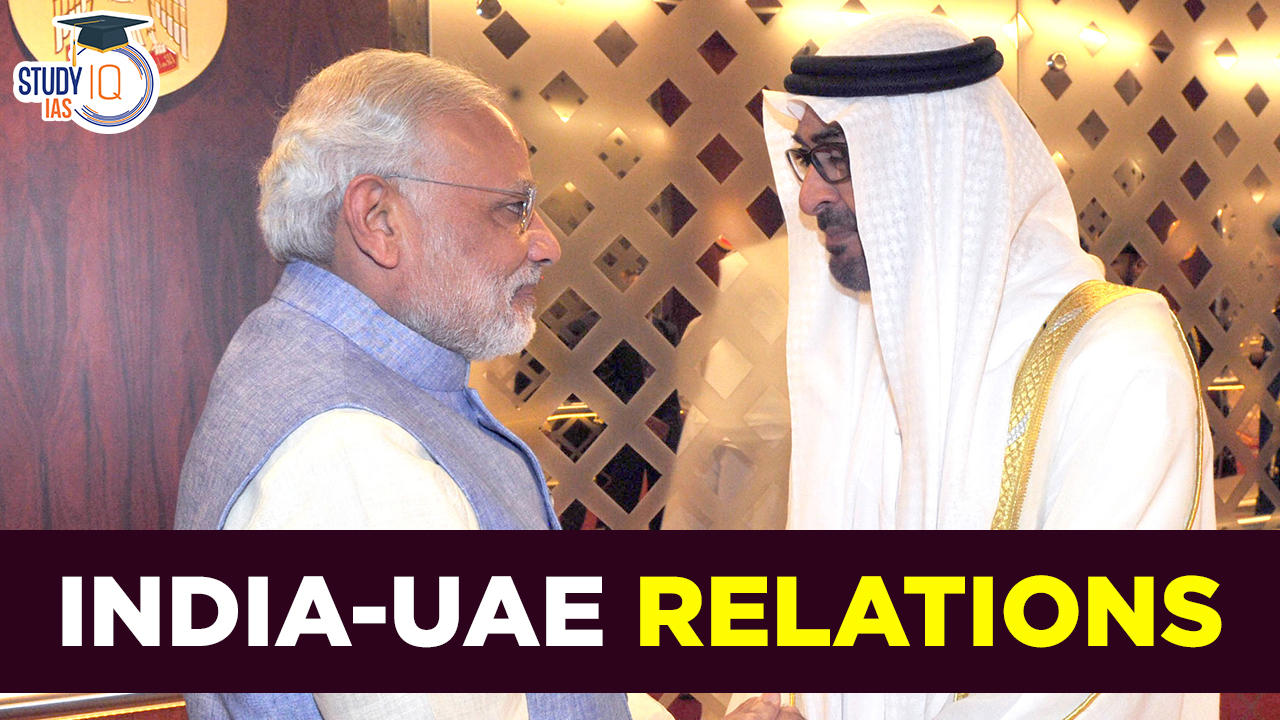Table of Contents
Context: India and the UAE have set a target to increase the non-oil trade from USD 48 billion to USD 100 billion by 2030.
More on the News
- In the first meeting of the Joint Committee of the India-UAE Comprehensive Economic Partnership Agreement (CEPA) that took place recently, the target of achieving USD 100 billion in bilateral trade by 2030 was set.
- The CEPA which was implemented on May 1 2022 aims to promote economic cooperation and enhance trade relations between India and the UAE.
- It focuses on expanding non-oil sectors of trade, indicating that the target of USD 100 billion will not include oil trade.
- To facilitate the implementation of the agreement and address various trade-related issues, several sub-committees and councils will be established.
- One such sub-committee will specifically handle matters pertaining to services trade.
- Additionally, an India-UAE CEPA council will be set up to further streamline and support the implementation of the agreement.
India-UAE Comprehensive Economic Partnership Agreement (CEPA) Trade Deal:
The India-UAE Comprehensive Economic Partnership Agreement (CEPA) trade deal aims to strengthen economic ties between the two countries by enhancing bilateral trade, promoting investment, and expanding cooperation in various sectors.
Objectives of the Trade Deal
- Enhanced Market Access: The CEPA trade deal seeks to provide significant benefits to businesses in both India and the UAE, including improved market access and reduced tariffs. It aims to facilitate increased trade in goods and services between the two countries.
- Digital Trade Cooperation: The agreement includes a digital trade element, which is a first of its kind for both nations. It aims to foster cooperation on digital trade, covering areas such as paperless trading, digital payments, online consumer protection, intellectual property rights, and challenges faced by small and medium enterprises.
- Strengthening Economic Cooperation: The CEPA is expected to create new jobs, raise living standards, and provide wider social and economic opportunities in both nations. It also envisions advancing the collective interests of India, Israel, the UAE, and the United States by opening new routes for regional trade and connectivity.
Significance of the India-UAE CEPA Trade Deal
- Bilateral Trade Expansion: The objective is to increase trade in goods to $100 billion and trade in services to $15 billion within five years of signing the agreement, contributing to the growth of both economies.
- Access to West Asian and African Markets: Deepening the relationship with the UAE is anticipated to benefit Indian exporters by providing access to other West Asian countries, Africa, and parts of Europe. Indian goods can flow to other Gulf Cooperation Council (GCC) countries as the UAE has no customs barriers.
- Energy Cooperation: The UAE is a major supplier of crude oil, LPG, and LNG to India. The CEPA trade deal is expected to further strengthen bilateral energy ties and explore opportunities for cooperation in renewable energy.
- Job Creation: The trade deal has the potential to create new employment opportunities, improve living standards, and generate broader social and economic benefits for both countries.
Challenges of the India-UAE CEPA Trade Deal
- Lack of Negotiations: Negotiations for a free trade agreement with the Gulf Cooperation Council (GCC) countries, including the UAE, were initiated in 2007 but got stuck after a few rounds. This lack of progress poses a challenge in realizing the full potential of trade agreements and deeper economic integration.
- Capacity of Indian Businesses: Indian businesses, despite being part of a $2.5 trillion economy, are relatively small in size compared to global conglomerates. The capacity, infrastructure, and experience required to handle substantial investments may be lacking, hindering the realization of the full benefits of the trade deal.
- Procedural and Bureaucratic Challenges: Challenges such as lack of planning, incomplete information, and bureaucratic bottlenecks continue to pose hurdles for foreign investors, despite government efforts to improve the ease of doing business.
- Legal Issues: Past legal problems have dampened foreign investments in India, leading to concerns for potential investors. While regulations and checks are necessary, better streamlining of procedures and processes can help avoid such issues.
India-UAE Ties
India and United Arab Emirates (UAE) enjoy strong bonds of friendship based on age-old cultural, religious and economic ties between the two nations. The relationship flourished after the accession of H.H. Sheikh Zayed Bin Sultan Al Nahyan as the Ruler of Abu Dhabi in 1966 and subsequently with the creation of the UAE Federation in 1971. Since then, both sides have made sincere efforts to improve relations in all fields.
The UAE holds significant importance for India in its “Look East” and “Look West” policies in the following aspects:
- Look East Policy: As the UAE looks eastward to expand its economic growth, it finds India as a natural partner due to its rapidly growing economy, large consumer market, and skilled workforce.
- Look West Policy: The UAE is equally important for India in its Look West Policy, which aims to deepen ties with countries in West Asia. India’s political and diplomatic engagements with the UAE have significantly increased in recent times, and the two countries have established a strategic partnership. The UAE serves as a willing partner for India in its efforts to enhance economic engagement and security cooperation in the Gulf region. With the UAE’s “Look East” approach aligning with India’s Look West Policy, the two countries find mutual benefits in expanding trade, investment, and security collaboration. The UAE’s geographic location, stability, and status as a major economic and financial hub in the region make it a key player in India’s West Asia policy.
Areas of Cooperation
India and the UAE have cooperated in various areas to strengthen their bilateral relations.
- Political and Diplomatic Relations: India and the UAE have established a comprehensive strategic partnership, leading to high-level visits and engagements. This includes the historic visit of the Indian Prime Minister to the UAE in 2015, which marked the beginning of a new strategic partnership. The UAE’s Crown Prince also visited India in 2017. The two countries have institutionalized their political and diplomatic engagements through mechanisms like the UAE-India Strategic Dialogue.
- Trade and Investment: The UAE is India’s third-largest trade partner and second-largest export destination. Bilateral trade reached approximately USD 72 billion in the fiscal year 2021-22. The UAE has made substantial investments in India, with sectors such as construction development, power, air transport, tourism, and metallurgical industries receiving significant investment.
- Energy Cooperation: Indian oil companies have been granted a 10 percent participating interest in the Lower Zakum offshore oil field. Additionally, the UAE has participated in operationalizing India’s strategic oil reserve in Mangalore. These initiatives have transformed the traditional buyer-seller relationship into a long-term investor relationship.
- Security and Counterterrorism: India and the UAE have enhanced cooperation in countering terrorism, combating radicalization, and preventing terror financing. Both countries view each other as important partners in maintaining peace and stability in their respective regions. Intelligence sharing, joint exercises, and naval cooperation have been undertaken to strengthen security ties.
- Desert Eagle II’, a ten day air combat exercise, was held between the air forces of India and UAE.
- The maiden bilateral naval exercise ‘Gulf Star 1′ took place in March 2018.
- Culture and Diaspora: The cultural agreement signed in 1975 has facilitated cultural exchanges between India and the UAE. The UAE hosts a significant Indian diaspora, with approximately 3.4 million Indian expatriates residing there. The two countries have collaborated to develop efficient grievance-redressal mechanisms for Indian workers in the UAE.
- Technology Partnerships: India and the UAE have signed agreements and partnerships in digital innovation and technology. Collaborations between the Indian Space Research Organisation (ISRO) and the UAE Space Agency (UAESA) have been established. The UAE has offered residency permits to experts in high-end technology fields, further promoting technology cooperation.
Challenges in India-UAE Relations
- Slow implementation of investments: The establishment of a $75 billion investment fund by the UAE for infrastructure projects in India, announced in 2015, has faced delays in finalizing the modalities and governance structure. This slow implementation hampers the realization of investment commitments.
- Lack of clarity and transparency: Indian companies operating in the UAE often face challenges due to a lack of clarity in commercial regulations and labor laws. Additionally, a lack of transparency on the part of Emirati businesses adds to the difficulties faced by Indian companies.
- Issues concerning the Indian diaspora: Indian migrants in the UAE face cumbersome and strict regulations, particularly in relation to Emirati employers. Problems such as favouritism towards workers of other nationalities and a slight drop in remittances inflow from the UAE to India have been observed.
- Influence of the Pakistan factor: Historical and civilizational ties between India and the Gulf region are strained due to the influence of the Pakistan factor. Political relations are affected by tensions between India and Pakistan, which impact India’s relations with countries in the region.
- Balancing geopolitics: India’s relations with Iran and the UAE’s relations with China create a dynamic where geopolitical considerations can sometimes challenge the bilateral relationship between India and the UAE.
- Energy pricing disagreements: As an OPEC country, the UAE has a different perspective on energy pricing compared to India, a major oil consumer. Disagreements over energy pricing, including India’s call for a cap on prices, have led to heated exchanges between oil ministers in the past.
- Air services agreement: India and the UAE have yet to renegotiate their air services agreement. The UAE seeks to increase the number of flights and destinations to India, while India maintains certain caps to protect its domestic airlines. This issue has been a source of contention between the two countries.
Addressing these challenges through dialogue, negotiation, and mutual understanding will be essential to further strengthen and deepen the India-UAE relationship.


 Why is English Important for UPSC IAS Ex...
Why is English Important for UPSC IAS Ex...
 Editorial of the Day (10th May): AI and ...
Editorial of the Day (10th May): AI and ...
 Current Affairs 10th May 2024 for UPSC P...
Current Affairs 10th May 2024 for UPSC P...

















